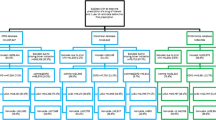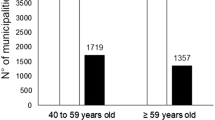Abstract
Stratification and conditioning on time-varying cofounders which are also intermediates can induce collider-stratification bias and adjust-away the (indirect) effect of exposure. Similar bias could be expected when one conditions on time-dependent PS. We explored collider-stratification and confounding bias due to conditioning or stratifying on time-dependent PS using a clinical example on the effect of inhaled short- and long-acting beta2-agonist use (SABA and LABA, respectively) on coronary heart disease (CHD). In an electronic general practice database we selected a cohort of patients with an indication for SABA and/or LABA use and ascertained potential confounders and SABA/LABA use per three month intervals. Hazard ratios (HR) were estimated using PS stratification as well as covariate adjustment and compared with those of Marginal Structural Models (MSMs) in both SABA and LABA use separately. In MSMs, censoring was accounted for by including inverse probability of censoring weights.The crude HR of CHD was 0.90 [95 % CI: 0.63, 1.28] and 1.55 [95 % CI: 1.06, 2.62] in SABA and LABA users respectively. When PS stratification, covariate adjustment using PS, and MSMs were used, the HRs were 1.09 [95 % CI: 0.74, 1.61], 1.07 [95 % CI: 0.72, 1.60], and 0.86 [95 % CI: 0.55, 1.34] for SABA, and 1.09 [95 % CI: 0.74, 1.62], 1.13 [95 % CI: 0.76, 1.67], 0.77 [95 % CI: 0.45, 1.33] for LABA, respectively. Results were similar for different PS methods, but higher than those of MSMs. When treatment and confounders vary during follow-up, conditioning or stratification on time-dependent PS could induce substantial collider-stratification or confounding bias; hence, other methods such as MSMs are recommended.

Similar content being viewed by others
Abbreviations
- ATC:
-
Anatomical therapeutic chemical classification system
- CHD:
-
Coronary heart disease
- CI:
-
Confidence interval
- COPD:
-
Chronic obstructive pulmonary disease
- DAG:
-
Direct acyclic graph
- GPRD:
-
General practice research database
- HR:
-
Hazard ratio
- ICPC:
-
International classification of primary care system
- IPTW:
-
Inverse probability of treatment weights
- LABA:
-
Long-acting beta2-agonist
- MI:
-
Myocardial infarction
- MSM:
-
Marginal structural model
- PS:
-
Propensity score
- SABA:
-
Short-acting beta2-agonist
- SD:
-
Standard deviation
References
Rosenbaum PR, Rubin DB. The central role of the propensity score in observational studies for causal effects. Biometrika. 1983;70:41–55.
Shah BR, Laupacis A, Hux JE, Austin PC. Propensity score methods gave similar results to traditional regression modeling in observational studies: a systematic review. J Clin Epidemiol. 2005;58:550–9.
Stürmer T, Joshi M, Glynn RJ, Avorn J, Rothman KJ, Schneeweiss S. A review of the application of propensity score methods yielded increasing use, advantages in specific settings, but not substantially different estimates compared with conventional multivariable methods. J Clin Epidemiol. 2006;59:437–47.
Marcus SM, Siddique J, Ten Have TR, Gibbons RD, Stuart E, Normand SLT. Balancing treatment comparisons in longitudinal studies. Psychiatr Ann. 2008;38:805–11.
Stricker BHC, Stijnen T. Analysis of individual drug use as a time-varying determinant of exposure in prospective population-based cohort studies. Eur J Epidemiol. 2010;25:245–51.
Robins JM, Hernán MÁ, Brumback B. Marginal structural models and causal inference in epidemiology. Epidemiology. 2000;11:550–60.
Hernán MÁ, Brumback B, Robins JM. Marginal structural models to estimate the causal effect of zidovudine on the survival of HIV-positive men. Epidemiology. 2000;11:561–70.
Robins JM. Marginal structural models. Section on Bayesian Statistical Science: Proceedings or the American Statistical Association; 1997. p. 1–10.
Robins JM, Greenland S. Identifiability and exchangeability for direct and indirect effects. Epidemiology. 1992;3:143–55.
Greenland S. Quantifying biases in causal models: classical confounding vs collider-stratification bias. Epidemiology. 2003;14:300–6.
Whitcomb BW, Schisterman EF, Perkins NJ, Platt RW. Quantification of collider-stratification bias and the birth weight paradox. Paediatr Perinat Epidemiol. 2009;23:394–402.
Segal JB, Griswold M, Achy-Brou A, et al. Using propensity scores subclassification to estimate effects of longitudinal treatments: an example using a new diabetes medication. Med Care. 2007;45:S149–57.
Westreich D, Cole SR, Funk MJ, Brookhart MA, Stürmer T. The role of the c-statistic in variable selection for propensity score models. Pharmacoepidemiol Drug Saf. 2011;20:317–20.
Spitzer WO, Suissa S, Ernst P, et al. The use of β-agonists and the risk of death and near death from asthma. N Engl J Med. 1992;326:501–6.
Au DH, Curtis JR, Every NR, McDonell MB, Fihn SD. Association between inhaled β-agonists and the risk of unstable angina and myocardial infarction*. Chest. 2002;121:846–51.
Au DH, Lemaitre RN, Randall Curtis J, Smith NL, Psaty BM. The risk of myocardial infarction associated with inhaled beta-adrenoceptor agonists. Am J Respir Crit Care Med. 2000;161:827–30.
Suissa S, Assimes T, Ernst P. Inhaled short acting β agonist use in COPD and the risk of acute myocardial infarction. Thorax. 2003;58:43–6.
Salpeter SR, Ormiston TM, Salpeter EE. Cardiovascular effects of β-agonists in patients with asthma and COPD*. Chest. 2004;125:2309–21.
De Vries F, Pouwels S, Bracke M, et al. Use of β2 agonists and risk of acute myocardial infarction in patients with hypertension. Br J Clin Pharmacol. 2008;65:580–6.
Sears MR. Safety of long-acting β-agonists. Chest. 2009;136:604–7.
Zhang B, de Vries F, Setakis E, van Staa TP. The pattern of risk of myocardial infarction in patients taking asthma medication: a study with the general practice research database. J Hypertens. 2009;27:1485–92.
R Development Core Team. R: a language and environment for statistical computing. R foundation for statistical computing. Vienna, Austria. 2011; ISBN 3-900051-07-0, URL http://www.R-project.org/.
Cole SR, Hernán MA. Constructing inverse probability weights for marginal structural models. Am J Epidemiol. 2008;168:656–64.
Greenland S, Robins JM. Identifiability, exchangeability, and epidemiological confounding. Int J Epidemiol. 1986;15:413–9.
Greenland S, Robins JM, Pearl J. Confounding and collapsibility in causal inference. Statist Sci. 1999;14:29–46.
Martens EP, Pestman WR, de Boer A. Systematic differences in treatment effect estimates between propensity score methods and logistic regression. Int J Epidemiol. 2008;37(5):1142–7.
Rosenbaum PR, Rubin DB. Reducing bias in observational studies using subclassification on the propensity score. J Am Stat Assoc. 1984;79(387):516–24.
Rubin DB. Estimating causal effects from large data sets using propensity scores. Ann Intern Med. 1997;127:757–63.
Peduzzi P, Concato J, Feinstein AR, Holford TR. Importance of events per independent variable in proportional hazards regression analysis II. Accuracy and precision of regression estimates. J Clin Epidemiol. 1995;48:1503–10.
Peduzzi P, Concato J, Kemper E, Holford TR, Feinstein AR. A simulation study of the number of events per variable in logistic regression analysis. J Clin Epidemiol. 1996;49:1373–9.
Cepeda MS, Boston R, Farrar JT, Strom BL. Comparison of logistic regression versus propensity score when the number of events is low and there are multiple confounders. Am J Epidemiol. 2003;158:280–7.
Vittinghoff E, McCulloch CE. Relaxing the rule of ten events per variable in logistic and Cox regression. Am J Epidemiol. 2007;165:710–8.
Kurth T, Walker AM, Glynn RJ, et al. Results of multivariable logistic regression, propensity matching, propensity adjustment, and propensity-based weighting under conditions of nonuniform effect. Am J Epidemiol. 2006;163:262–70.
Hernán MA, Hernández-Díaz S, Robins JM. A structural approach to selection bias. Epidemiology. 2004;15:615–25.
Lee BK, Lessler J, Stuart EA. Weight trimming and propensity score weighting. PLoS ONE. 2011;6:e18174. doi:10.1371/journal.pone.0018174.
Acknowledgments
The research leading to these results was conducted as part of the PROTECT consortium (Pharmacoepidemiological Research on Outcomes of Therapeutics by a European ConsorTium, www.imi-protect.eu) which is a public–private partnership coordinated by the European Medicines Agency. The PROTECT project has received support from the Innovative Medicine Initiative Joint Undertaking (www.imi.europa.eu) under Grant Agreement n° 115004, resources of which are composed of financial contribution from the European Union’s Seventh Framework Programme (FP7/2007-2013) and EFPIA companies’ in kind contribution. The views expressed are those of the authors only.
Conflict of interest
The department of Pharmacoepidemiology and Clinical Pharmacology, Utrecht Institute for Pharmaceutical Sciences, has received unrestricted research funding from the Netherlands Organisation for Health Research and Development (ZonMW), the Dutch Health Insurance Board (CVZ), the Royal Dutch Association for the Advancement of Pharmacy (KNMP), the private–public funded Top Institute Pharma (www.tipharma.nl), includes co-funding from universities, government, and industry), the EU Innovative Medicines Initiative (IMI), EU 7th Framework Program (FP7), the Dutch Medicines Evaluation Board, the Dutch Ministry of Health and industry (including GlaxoSmithKline, Pfizer, and others).
Author information
Authors and Affiliations
Corresponding author
Additional information
This study was conducted on behalf of PROTECT WP2 (Framework for pharmacoepidemiology studies, full list of collaborators in “Appendix 2”). The PROTECT consortium (Pharmacoepidemiological Research on Outcomes of Therapeutics by a European ConsorTium) is a private–public partnership coordinated by the European Medicines Agency (EMA).
Appendices
Appendix 1
To evaluate the sensitivity of the treatment-effect estimate to the three-month intervals treatment classification, standard risk-set analysis was performed. A risk-set was constructed based on occurrence of the event (CHD), then every time an event occurs, changes in treatment (SABA/LABA use) status as well as other potential confounders were ascertained for each patient at risk in contrast to the three-month intervals approach. A patient could contribute several person-times in the risk-set and SABA/LABA use was not constrained by three-month interval but only occurrence of an event. A time-varying Cox model was then fitted on strata of the risk set (strata = number of unique events times). Table 5 shows the crude and adjusted HRs for CHD associated with the use of inhaled SABA and LABA, when treatment and confounders were defined in the risk-set approach and adjustment was made for time-dependent confounders. Similar results were obtained when treatment classification was based on the three-month interval approach (Table 3 of the manuscript).
Appendix 2
Members of PROTECT WP2 (Framework for pharmacoepidemiology studies): Y. Alvarez, J. Slattery, X. Kurz (European Medicines Agency), M. Rottenkolber, J. Hasford, A. Sassenfeld (Ludwig-Maximilians-Universität-München), F. J. (de) Abajo Iglesias, M. Gil, C. Huerta, D. Montero (Agencia Espanola de Medicamentos y Productos Sanitarios), L.A. Garcia-Rodriguez, A. Ruigomez (Fundación Centro Español de Investigación Farmacoepidemiológica), P. Souverein, D. de Bakker, A. de Boer, R. Groenwold, S. Belitser, W. Pestman, K. Roes, A. Hoes, V. Abbing-Karahagopian, F. de Vries, T.P. van Staa, A.C.G. Egberts, H.G.M. Leufkens, L. van Dijk, O.H. Klungel, M. De Groot, R. van den Ham, M. Sanni Ali, E. Voogd, M. J. Uddin (Utrecht University, The Netherlands), A. M. Gallagher, D. Dedman, J. Campbell (The UK General Practice Research Database), P. Helboe, J. Lyngvig, AM Clemensen, TS Engraff, U. Hesse, J. Poulsen (Lægemiddelstyrelsen, Danish Medicines Agency), John Logie, Jeanne Pimenta (GlaxoSmithKline Research and Development LTD), L. Bensouda-Grimaldi, L. Abenhaim (L.A. Sante Epidemiologie Evaluation Recherche), R.F. Reynolds, N. Gatto, A. Bate (Pfizer), G.F. Downey, R. Brauer, M. Schoonen, A. Roddam (Amgen NV), O. Demol (Genzyme Europe), M. Miret (Merck KgaA), S. Johansson (AstraZeneca AB), P. Primatesta, R. Schlienger, J. Fortuny, E. Rivero (Novartis), G. Quartey, H. Petri, M. Schuerch, J. Robinson (F.Hoffmann-La Roche AG), J.R. Laporte, L. Ibañez, M. Sabaté, E. Ballarin, P. Ferrer (Fundació Institut Català de Farmacologia).
Rights and permissions
About this article
Cite this article
Sanni Ali, M., Groenwold, R.H.H., Pestman, W.R. et al. Time-dependent propensity score and collider-stratification bias: an example of beta2-agonist use and the risk of coronary heart disease. Eur J Epidemiol 28, 291–299 (2013). https://doi.org/10.1007/s10654-013-9766-2
Received:
Accepted:
Published:
Issue Date:
DOI: https://doi.org/10.1007/s10654-013-9766-2




